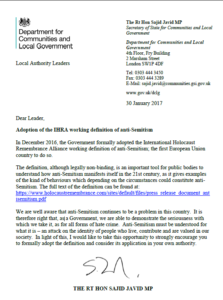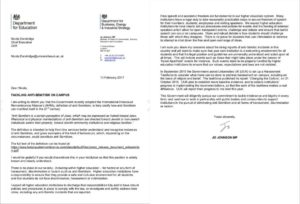Mike Cushman
Theresa May misled the British public by pretending that the IHRA definition of antisemitism included the examples linking antisemitism to criticism of Israel and urging all public bodies to collude in this chilling of free speech.
A year ago, Theresa May urged all UK public bodies to adopt the IHRA (International Holocaust Remembrance Alliance) document on antisemitism. The document contained a 39 word definition:
Antisemitism is a certain perception of Jews, which may be expressed as hatred toward Jews. Rhetorical and physical manifestations of antisemitism are directed toward Jewish or non-Jewish individuals and/or their property, toward Jewish community institutions and religious facilities
It also lists 11 illustrative examples of antisemitism, seven of them relating to Israel.
It has always seemed strange that the IHRA website contained no details of the document’s adoption and the only record of it is a press release from the Romanian chair. ECCP (European Coordination of Committees and Associations for Palestine) has pressed hard to discover what lay behind this strange lack of documentation and has finally obtained confirmation from the IHRA secretariat that, while the 39 word definition was adopted, the examples were not.
While the Government press release announcing the Government’s adoption of the definition is ambiguous about its scope, the Government’s response to the Home Affairs Select Committee leaves no room for doubt. The Committee wished to add ‘without additional evidence to suggest antisemitic intent’ to three of the most contentious examples. The Government’s response makes clear that they, like the Committee, assert the definition includes the examples.
Theresa May announced the adoption, not in Parliament where she might have been challenged, but at a meeting of Conservative Friends of Israel. At the meeting, she described Israel as a state that “guarantees the rights of people of all religions, races and sexualities”. Not only is that manifestly untrue in relation to both Palestinians and Jews of Ethiopian descent; it deliberately confuses criticism of Israel with antisemitism experienced by British Jews.
May must have known that only the short definition had been adopted but her Government has been rolling it out as including the eleven exemplars. The definition itself is poor: what is ‘a certain perception’; why is ‘hatred towards Jews’ reduced to a disposable extra; what is antisemitism towards non-Jews or their property? The exemplars, however, are beyond doubt an attack on the free expression guaranteed by UK and European law as demonstrated by Hugh Tomlinson QC. Use of them to restrict activity or speech would, in the QC’s opinion, be unlawful. May and her Government have not ceased urging public bodies to adopt the examples despite their dubious legality and fraudulent provenance.

In January 2017 Sajid Javid, Secretary of State for Communities and Local Government, wrote to all local authorities urging them to adopt the definition and commending the examples, saying: ‘it gives examples of the kind of behaviours which depending on the circumstances could constitute anti-Semitism’.
Regrettably many Councils have responded to Javid’s call. All too often they have done this by forcing through adoption without consultation or debate and refused to respond to criticisms of their actions.
While some Councils such as Newham have amended and mitigated some of the worst aspects of the document, others have made it worse. The strident advocacy group We Believe in Israel —itself an offshoot of BICOM, the Israel promotion organisation from which leading members of Labour Friends of Israel graduated—promoted a doctored version. Their version omitted, silently, the qualifier ‘depending on context’ from the preamble to the examples. This more aggressive text, going beyond Javid’s encouragement, has been adopted by several councils.

In February 2017, Jo Johnson, Minister for Higher Education, urged the whole document on Universities, particularly in relation to Israel Apartheid Week activities. As a result, students and staff in several universities have had their rights to free expression curtailed for partisan reasons and risked disciplinary action.
In May the Zionist Federation urged all parliamentary candidates to back the definition.
When the Labour Party NEC discussed adoption they, singularly, restricted adoption to the 39 words.
The examples themselves are bad enough but they are marginally limited by their introduction: “Contemporary examples of antisemitism … could, taking into account the overall context, include, but are not limited to…”. Even this constraint is too much for Israel’s more militant apologists. They have become fond of stating that an activity they disapprove of is, without qualification, antisemitic under the definition; urging churches, Local Authorities, universities, the police and others to take punitive action on this amplified interpretation. We have not noted any occasion on which a Government spokesperson has criticised them for this unmandated extension.
Labour Party bureaucrats, despite the Party’s restricted adoption of the IHRA definition, extended its reach still further in their action against Moshé Machover. They redefined the IHRA to include ‘pejorative language which may cause offence to Jewish people’.
The definition itself has a troubled history. It is a mildly revised version of a draft working definition circulated by, but never adopted by the European Union Monitoring Committee on Racism and Xenophobia (EUMC) in 2005. It was widely criticised and formally retired by the EUMC’s successor body. Despite that Israel’s defenders continued to promote it and use it and behind the scenes sought its revalidation by another body.
The EUMC definition was based on a draft by Kenneth Stern of the American Jewish Committee. In 2016 Stern testified to the US Congress that he opposed his definition being codified into law; it was only intended as an aid to diplomats.
May’s shameless fraud is achieving its desired result, the emboldening of all those who wish to suppress criticism of Israel. It is an attempt to allow only convenient historical analysis and anodyne commentary on the mistreatment of Palestinians. Early British assertion of the inclusion of the examples in the definition is being used in Europe and beyond by forces wishing to bolster Israel. The document is regularly cited by those who attempt to disrupt and close down public meetings on Palestine and Israel.
May has also energised those who wish to remove Zionist blinkers and freely debate Israel and Palestine. We will continue to speak out and defy those who would brand ethical campaigning as antisemitic.




Yes I often wondered why the only source documentation for this is a rather scrappy Romanian press release! Thanks for clearing that up.
What is and should be clear is that even the 39 word introduction should be opposed root and branch because it is a necessary qualifier and introduction to the 11 examples. However it is interesting to note that even the IHRA itself didn’t adopt the 11 examples